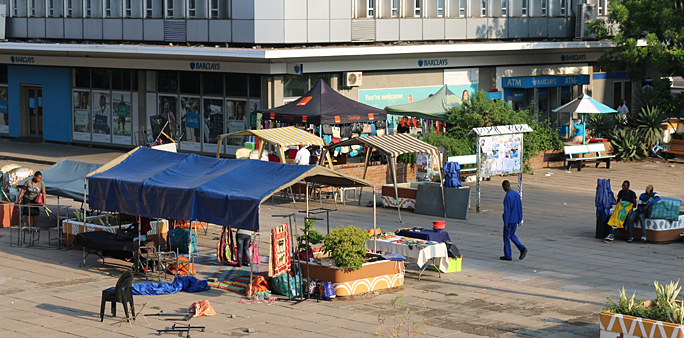T he sun was first rising that sultry morning as I awoke in the capital city of Botswana. It was still quiet outside; but signs of life began stirring about on the street outside of the central police station. I went downstairs to have some breakfast, which was included in the room rate.
Among the items I had for breakfast was watermelon. Why? “Watermelon is thought to have originated in the Kalahari Desert of Africa” — much of which is in Botswana — according to this article of the National Watermelon Promotion Board.

Needless to say, the watermelon was delicious…

…and as I sat on the balcony outside, I looked off to the right and noticed people below setting up stands and tents, preparing to spend the day selling their wares. I had planned on heading over to Botswanacraft to purchase some items which were made locally; but I decided instead to peruse what the local merchants were selling.

I first headed over to the Western Union on the second floor next to the Spar market to exchange currency. Appropriately, the song Pata Pata — not the version sung by South African singer Miriam Makeba which was released in 1957 but became a hit song in the United States ten years later — played over the speaker in the ceiling as I conducted my currency exchange transaction.

The rate at the Western Union office was 9.35 Botswana pula to the United States dollar with no exchange rate — far better than the 8.2 pula which was being charged per United States dollar at the Tlokweng Gate border crossing with South Africa. However, I was required to exchange currency there to pay for mandatory MVI third-party motor vehicle insurance for the rental car which I was driving for 50 pula; the RTP road permit fee of 40 pula; and the NRF Road Fund fee of 50 pula. That was a grand total of fewer than $17.50 — even with the poor exchange rate.
Pula in pocket, I strolled the outdoor mall, which extended uninterrupted for the equivalent of several city blocks near central Gaborone — affectionately known by locals as Gabs. None of the merchants called me out for my business. Some played music; others chatted with a colleague; still others sat there alone, reading a book. It was the perfect combination of an African atmosphere which was civilized. They left me alone unless I approached them. No hard sells. It was a nice experience; and I purchased a couple of small items.

My limited experience with the people of Botswana is that they are friendly, helpful and seemed refined; but without losing their sense of origin or abandoning their heritage. Botswana was once one of the poorest countries in the world — but its gross domestic product continues to improve; and the economy of Botswana has become one of the fastest growing economies in the world.
It does not take long to see that the people of Botswana are hard working and proud. The blue, black and white — the national colors of Botswana — are everywhere; and one can tell that the people are proud of their country and its growing success. There is definitely a lot of potential for Botswana in the future.
Approximately ten percent of the population of Botswana — approximately the size of France and yet one of the most sparsely populated countries in the world — resides in Gaborone; and although I did experience some traffic on the roads, I never felt like it was uncomfortably crowded. In fact, the pedestrian mall never really became more crowded than what is shown in the photographs above.
Unfortunately, there really is not that much to do in Gaborone even though there are nature and game reserves; but I had just been on a safari in Kenya — I have already posted photographs of a one-eyed lion and a lioness; and a cheetah successfully hunting its prey, with additional photographs to come — and was not really interested in that. I was told that the Gaborone Dam was dry and not interesting; and that solo hikers of Kgale Hill have been known to be mugged and robbed of their cameras — so I decided against those options. The hot and humid air was ripe for thunderstorms — which did occur later in the day — and I did not want to be caught on Kgale Hill during that type of weather. Besides — save for a few hills and small mountains — much of the landscape of Botswana is flat; and there is no skyline of which to speak in Gaborone anyway.
After checking out of the hotel where I stayed for the night and purchasing those aforementioned items, I decided to visit a place called Matsieng’s Footprints — a report of which is included in this article…
…but all in all, it was a pleasant morning spent in Gaborone, Botswana.
All photographs ©2015 by Brian Cohen.


